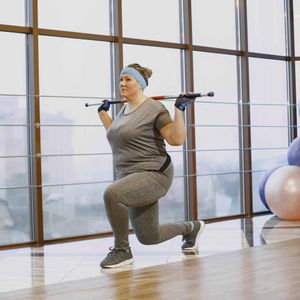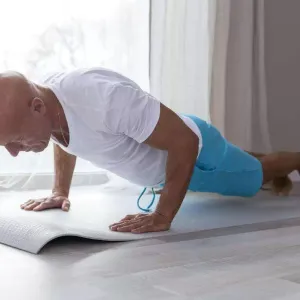

Our Review Process
Our articles undergo extensive medical review by board-certified practitioners to confirm that all factual inferences with respect to medical conditions, symptoms, treatments, and protocols are legitimate, canonical, and adhere to current guidelines and the latest discoveries. Read more.
Our Editorial Team
Shifa Fatima, MSc.
Author
Dr. Apoorva T, MHM.
MEDICAL ADVISOR
Exercise-induced Hypoglycemia
A medical term used for low blood sugar levels after exercise is what we call Exercise-induced hypoglycemia. A few symptoms occur during Exercise-induced hypoglycemia, like shakiness, weakness, and fatigue. Glucose is the primary source of energy for our body, and it gets consumed faster during exercise; thus, there is a need for more glucose during hypoglycemia exercise.
The need for more glucose during exercise triggers Exercise-induced hypoglycemia (other factors also play a role). Exercise-induced hypoglycemia, in simple terms, is a situation in which there is a shortage of glucose in the body, thus a shortage of energy to meet body needs. Usually, a glucose level lower than 70 milligrams per decilitre is what doctors consider to be hypoglycemia.
Table of Contents
What is Exercise-induced Hypoglycemia?
Due to an imbalance between nutrition, training volume, and other external influences like temperature and altitude, people can face what we call Exercise-induced hypoglycemia. It is a situation in which there is a shortage of glucose which happens to be the primary source of energy for our body. Carbohydrates are metabolised to get glucose, and glucose, in turn, provides energy to the body. This glucose enters the bloodstream, and the responding pancreas produces insulin. The insulin produced by the pancreas helps the glucose enter the cells and use it as fuel. During exercise, extra energy is needed in terms of glucose due to the extra exertion that one goes through. But due to the lack of glucose, we experience Exercise-induced hypoglycemia.
Symptoms of Exercise-induced Hypoglycemia
There are several symptoms one may go through due to Exercise-induced hypoglycemia.
One can experience weakness, which is common with Exercise-induced hypoglycemia. Other symptoms include shaking and dizziness. A person with Exercise-induced hypoglycemia can also experience anxiety, fainting and confusion.
Hypoglycemia can also become severe, causing life-threatening symptoms like seizures, coma or even death.
Causes of Exercise-induced Hypoglycemia
When a person exercises, the body demands extra energy to fulfil the additional need; this means an increased amount of energy is needed to burn more glucose. Exercise-induced hypoglycemia usually occurs in people who are already short on glucose levels, and exercising exacerbates the situation even further by demanding more glucose. Exercise-induced hypoglycemia may also occur in people whose bodies metabolise glucose rapidly. Several other factors contribute to Exercise-induced hypoglycemia, like;
- Not consuming adequate food or fasting.
- Sickness also leads to Exercise-induced hypoglycemia.
- Exercising immediately after consuming a meal.
- Consuming too much alcohol without food
- Not consuming adequate carbohydrates
- Using diabetes medications
The glucose levels also fall when exercising triggers a substantial spike in insulin levels. This spike in insulin can also lead to hypoglycemia (this can happen even if a person is nourishing themselves well and does not take any medication to lower his blood glucose levels).
A person who experiences Chronic Exercise-induced hypoglycemia should go to a health professional, who may recommend medication to reverse the condition.

Is Exercise-induced Hypoglycemia a Sign of Diabetes?
The answer to the question - is EIH a sign of diabetes - is "not necessarily". Exercise can decrease a person’s blood glucose levels significantly. But it needs to be kept in mind that people who have diabetes have higher risk factors related to hypoglycemia.
Diabetes that remains untreated is what causes hyperglycemia (high blood glucose).
People who have diabetes and take medications that are more than what is required to manage it are the ones who are at a higher risk of hypoglycemia. Not consuming enough food that can provide sufficient energy to the body also acts as a cause. People taking medications for diabetes during a restrictive diet and fasting may also suffer from hypoglycemia.
Treatment for Exercise-induced Hypoglycemia
Though mild, Exercise-induced hypoglycemia does not require any treatment. To avoid Exercise-induced hypoglycemia, one should always eat a carbohydrate-rich diet an hour or two before exercise. Exercise-induced hypoglycemia usually occurs due to inadequate food before a workout or any other physical activity.
A doctor may even prescribe diazoxide to a person with low blood sugar. In some cases, a small part of the pancreas may also be removed to slow down the process of insulin production. There is a hypoglycemia exercise that one can follow.
Preventing Exercise-induced Hypoglycemia
Eating meals with all the necessary nutrients required (especially carbohydrates) throughout the day is recommended. Avoiding alcohol is also recommended. New exercise routines should give the body sufficient time to adapt. Some options for people who have diabetes include 4 oz of juice/soda, 1 tablespoon of sugar, and 1 glucose tube.
Also read about the symptoms of low blood sugar.
When to seek help
Usually, hypoglycemia is not life-threatening, but it can become life-threatening in rare cases. This happens if the blood glucose levels drop drastically. If the person experiences symptoms, he needs immediate medical attention; these symptoms include loss of consciousness, confusion or seizures. A person who experiences Exercise-induced hypoglycemia or hypoglycemia should consult a doctor immediately. A person can also ask for a tailored hypoglycemia exercise from a health professional. Also know about fasting blood sugar level.
FAQs
Can Too Much Exercise Cause Hypoglycemia?
Not every person has the same health conditions; hence exercise is not always the causative factor behind hypoglycemia. But in some cases, exercises can trigger a sudden insulin spike, resulting in the removal of glucose from blood sugar levels. Such sudden spikes can give rise to hypoglycemia even if the person is not taking any medication to reduce the blood glucose levels or is well nourished.
How Long Does Exercise-Induced Hypoglycemia Last?
Your blood sugar levels may drop and remain on the lower side after a moderate, intense exercise session for 24 hours. But if you consume approximately 15 grams of carbohydrates after exercise, you can prevent your blood sugar levels from dropping to harmful levels.
How Can I Avoid Hypoglycemia After Exercise?
If you have experienced hypoglycemia after exercise, you can take some tried-and-tested measures to prevent it in the future. Things like not eating close to exercise hours, trying different foods during exercise, reducing bolus insulin, exercising at a glucose level above 140 mg/dL, and reducing basal insulin are some of the options you can try to prevent hypoglycemia after exercise.
How is Exercise-Induced Hypoglycemia Diagnosed?
You can find out whether you have exercise-induced hypoglycemia by looking for its symptoms. People who get exercise-induced hypoglycemia show signs like shakiness, fainting, dizziness, weakness, confusion, and anxiety. Prolonged hypoglycemia can be life-threatening, and if left untreated, you can also experience seizures or fall into a coma.
Bottomline
A person experiences hypoglycemia when the blood glucose levels drop drastically. This glucose level is essential to fulfil the body’s needs. Exercise-induced hypoglycemia occurs when the person does some kind of intense physical activity like exercising. Both types of people (who have diabetes and who don’t) are at risk of developing Exercise-induced hypoglycemia. It is more common for someone who takes insulin or any other medications that help them manage their blood glucose levels.
References
- https://www.medicalnewstoday.com/articles/exercise-induced-hypoglycemia-what-to-know
Disclaimer
This website's content is provided only for educational reasons and is not meant to be a replacement for professional medical advice. Due to individual differences, the reader should contact their physician to decide whether the material is applicable to their case.








